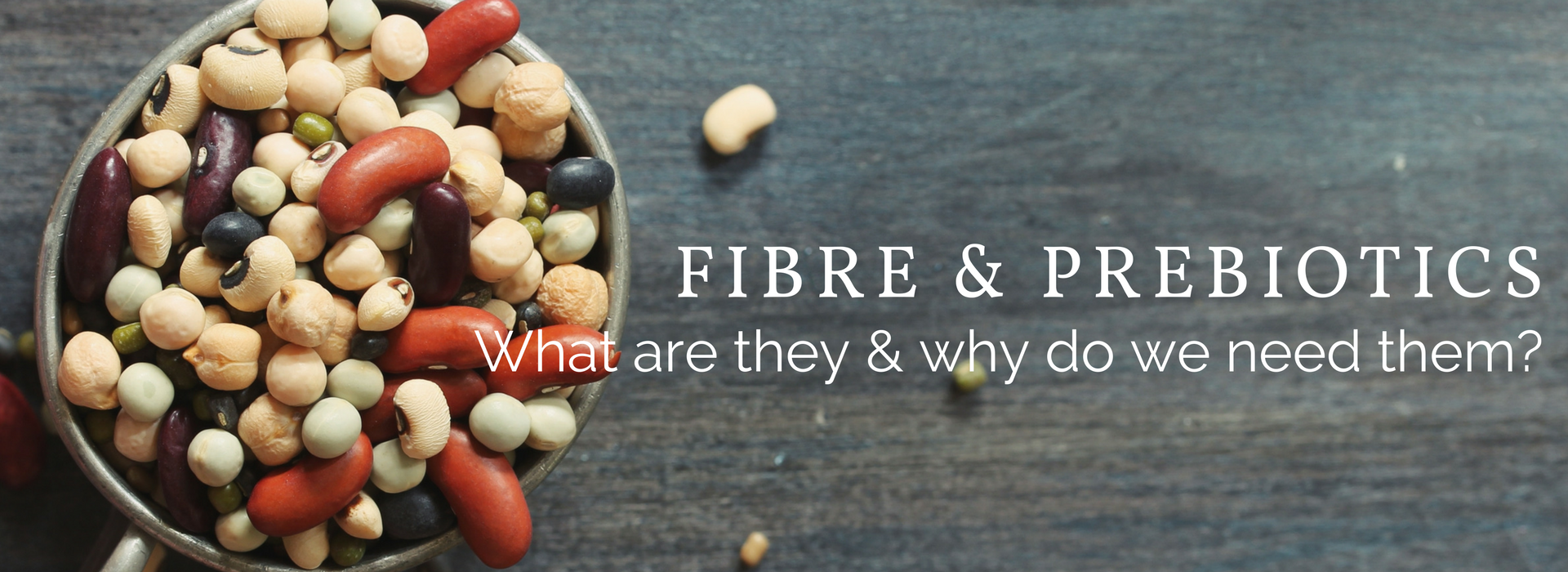Fibre and prebiotics are essential for good gut health. Many Australian’s don’t get enough from their diets. In this article I’ll take a closer look at how you can increase your intake of dietary fibre and prebiotics and improve your gut health.
What is Fibre?
First lets talk about dietary fibre. This is a type of carbohydrate the body can’t digest. Unlike the other types of carbohydrate (sugars and starches) fibre provides little to no calories. Instead of being broken down and absorbed, fibre just passes through the digestive tract.
Types of Fibre
There are two types of fibre; soluble and insoluble.
Soluble fibre dissolves in water and turns to gel which slows digestion and helps you feel full for longer after eating. This gel can bind to certain components in our food such as fats and sugars, and is particularly good at helping to lower cholesterol and stabilise blood glucose levels.
Food sources of soluble fiber include: legumes (peas and beans), barley, oat bran, chia seeds, psyllium husk and most fruits and vegetables.
Insoluble fibre on the other hand doesn’t dissolve in water. Instead it absorbs water like a sponge. This adds bulk to stools and helps digested food pass through the stomach and intestines. This makes insoluble fibre a particularly good treatment for constipation, provided it is taken with plenty of water.
Good sources of insoluble fibre are; whole grains, the outer skins of fruit and vegetables, nuts and seeds.
How much fibre do we need?
Australian dietary guidelines recommend eating at least 25-30g fibre per day. This is the amount required to keep the digestive system healthy and reduce the risk of constipation, diverticular disease, hemorrhoids, bowel cancer and cardiovascular disease.
What are Prebiotics?
The simple definition is a fermentable or non-digestible food component that promotes the health and growth of our gut microflora. In other words, prebiotics are what our gut bacteria use as a fuel source.
Prebiotics are always fibre, however not all fibre acts as a prebiotic. As mentioned before, fibre is a type of carbohydrate that the body can’t digest and passes through the digestive tract unchanged. Some of these indigestible fibres are prebiotic. Which means that when they reach the large intestine, the probiotic microorganisms that live there feed on them. They ferment them which produces short chain fatty acids (SCFA).
SCFAs have a variety of health benefits which I’ll cover shortly.
The main prebiotics are inulin and oligosaccharides, which are soluble fibres. Oligosaccharides can be further classified as fructo-oligosaccharides (FOS), Galacto-oligosaccharides (GOS), and Mannan-oligosaccharides (MOS).
There are other types of prebiotic fibres too. Resistant starch, for example is an insoluble fibre which passes through the stomach and small intestine unchanged. Once in the large intestine, the microbiota ferment resistant starch to produce SCFAs.
Another prebiotic fibre is pectin, a soluble fiber found in fruits and vegetables. Studies show that a diet high in pectin may reduce levels of pathogenic bacteria in the gut while increasing levels of friendly probiotic bacteria. Good sources of pectin include apples and kiwi fruit.
Foods particularly rich in prebiotics include: garlic, onions, leeks, bananas, asparagus, chicory, Jerusalem artichoke and dandelion greens.
Health benefits of prebiotics
Firstly, prebiotics are beneficial to our health because they provide a food source for our intestinal bacteria, thereby encouraging their growth. Without their food supply, our intestinal bacteria would become inactive and die.
As mentioned before, another important role of prebiotics is the increased production of short-chain fatty acids. These have a variety of health benefits including:
- providing fuel to nourish the cells lining the large intestine;
- reducing diarrhea and helping treat inflammatory bowel diseases;
- animal and lab studies show that SCFAs may protect against colon cancer. Although, more research is required;
- they seem to help regulate blood sugar levels, especially in those with diabetes or insulin resistance;
- animal studies show that SFCAs may help prevent and treat obesity. However, human studies are needed;
- they may decrease the risk of heart disease by reducing inflammation and cholesterol production
How much do we need?
Plants rich in prebiotic fibre have been consumed since prehistoric times. Evidence suggests that hunter-forager diets contained about 135g of inulin per day. Whereas the average modern western diet is estimated to provide only 1-10 grams per day.
There aren’t any set guidelines for prebiotic intake at this stage. However, by eating the recommended 25-30g of fibre daily, and including some prebiotic rich food sources daily you should get a good level of gut friendly prebiotic fibres.
So how can you increase your fibre and prebiotic intake?
Check out my blog post for a list of prebiotic foods. Unfortunately many of the best prebiotic food sources are not consumed regularly enough in western diets.
To give you an idea, below is an example of how an adult might meet their daily fibre requirements:
- 6.2g = 1 small banana and 1 small apple (with skin)
- 2.0g = 1 small sweet potato
- 8.7g = 1/4 cup chickpeas
- 10 g = 2 cups mixed raw vegetables
- 1.7g = 1/2 cup cooked rice
- 3.5g = 23 raw almonds
